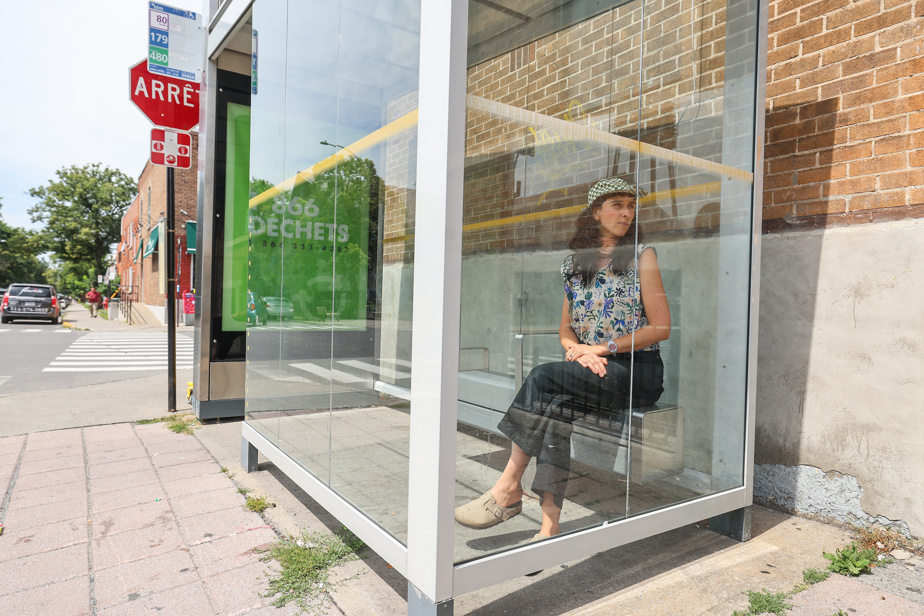With Gluereaders discover Parc-Extension through the eyes of a disillusioned narrator who seeks to elucidate the tragic death of one of her neighbors. The Press wandered through a neighborhood “off the wall” with the author Clémence Dumas-Côté.
The railway track
When I walk on the railway line, next to Jarry Park, I’m not really walking: I’m searching.
Excerpt from Glue
We begin the tour by crossing the iconic Jarry Park to stop on the Canadian Pacific railway track, which splits the neighbourhood in two. This is an important element in Clémence Dumas-Côté’s short story: the tracks often witness the conversations, reflections and dangerous behaviours of the characters in Gluewhich the “tracks” transform into tightrope walkers.
Walking on railways has always been a passion for the author. “It often sparks super rich conversations for me,” explains Clémence Dumas-Côté.
-

PHOTO MARTIN CHAMBERLAND, THE PRESS
Clémence Dumas-Côté on the Canadian Pacific railway track, which splits the Parc-Extension district in two.
-

PHOTO MARTIN CHAMBERLAND, THE PRESS
Clemence Dumas-Côte
1/2
” [C’est un espace] which evokes the transition,” she adds.
Transition is also how the writer describes Parc-Extension, which is the starting point for many newcomers and students like the author was during her stay in the area.
“It’s a place where we take turns in a race,” she describes.
Wiseman Avenue
Yet it is there, this strange mountain, gathering and thickening little by little, day by day, each time I pass by the corner of Jarry/Wiseman.
Excerpt from Glue
It is on Wiseman Avenue, near the intersection with Jarry Street, the main artery of the neighborhood, that the plot of the novel takes place. In the small residential street, where plexes, apartment buildings and houses are twinned, two ordinary apartment buildings oppose each other.
One is marked by drama from the first pages of the book, and throughout the story, the tension mounts as to whether the neighboring building will in turn be haunted by tragedy.
The narrator’s neighbors are eccentric, but familiar to anyone who has lived in an apartment, from the anxious student to the noisy family to the landlord caught up in the past.

PHOTO MARTIN CHAMBERLAND, THE PRESS
It is on Wiseman Avenue that the plot of Clémence Dumas-Côté’s novel takes place.
Although she returned to the neighborhood while writing the novel a few years ago, the author is surprised by the state of the old building where she lived 15 years ago and from which she drew inspiration for Glue.
“The owner, who was always there, I guess for 60 years, and smoked his little cigarette,” recalls Clémence Dumas-Côté. “It was very decrepit,” she notes, observing the façade of the sixplex.
Desi Mandi Grocery Store
I slide my fingers over the Pakistani mangoes, freshly arrived at Desi Mandi, around the corner from my house. I look for the ripest ones. I am the only woman in the grocery store. Around me, men are chatting loudly in a language that is less and less foreign to me, over the years I have lived in Parc-Ex. I am starting to recognize its sounds.
Excerpt from Glue
The writer describes her protagonist as an “observer,” both in the mystery she is trying to solve and in the neighborhood in general. In her many wanderings in Parc-Ex, a feeling of disorientation emerges, juxtaposed with the familiarity of home. She knows the landmarks, the shortcuts, the shops and the best restaurants, but the people are foreign to her.
Clémence Dumas-Côté wanted to write this book in particular to help people discover the neighborhood that welcomed her and so that its residents could identify with it.

PHOTO MARTIN CHAMBERLAND, THE PRESS
Desi Mandi Grocery Store
“That they feel that their reality exists and somewhere, compile certain things that they witness, their culture […]the culture of living in Parc-Ex, whether as an immigrant or a person of French-Canadian descent.
Afroditi Pastry
As we pass Afroditi’s on Rue Saint-Roch, we exchange a few sentences about our preferences in Greek pastries.
Excerpt from Glue
Parc-Extension is also a neighbourhood to discover with its flavours, smells and colours. With the help of Clémence Dumas-Côté’s picturesque descriptions, the reader is transported to the streets of Montreal, but also to India and Greece.
The narrator often stops at a popular local Greek pastry shop to buy treats, an experience borrowed from the author’s memories.

PHOTO MARTIN CHAMBERLAND, THE PRESS
Afroditi Pastry
“I would go to Afroditi and have these pastries that no one knows […]of the [kourabiedes] and melomakaronas,” she recalls. In her twenties, she often spent Sunday mornings there, before going to listen to a sermon at one of the many places of worship of various denominations in the area.
” If Glue was a neighborhood, it would be Parc-Extension, with its mosaic side, full of little facets that reflect each other,” explains the woman whose next work will be a collection of poetry, which should be in bookstores in the winter.

Glue (2022)
Red Herbs
160 pages
